| NORTH AMERICAN BABYDOLL SOUTHDOWN SHEEP ASSOCIATION & REGISTRY | ||||
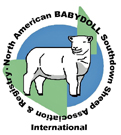 |
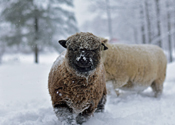 |
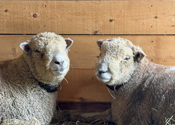 |
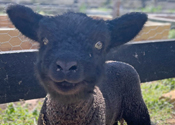 |
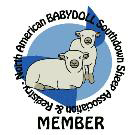 |
| Start your day with a SMILE...Own a BABYDOLL! | ||||
| NORTH AMERICAN BABYDOLL SOUTHDOWN SHEEP ASSOCIATION & REGISTRY | ||||
 |
 |
 |
 |
 |
| Start your day with a SMILE...Own a BABYDOLL! | ||||
In 1780, John Ellman from Glynde, England, took the local sheep known as Southdowns and systematically selected, developed and standardized them into what we now recognize as the considerably improved BABYDOLL Southdown; a breed destined to make its name a presence in sheep farming across the world because of Master Breeder John Ellman's work. In her book, author Valerie Porter wrote, "John Ellman once said, that it was more difficult to maintain a good breed than to raise it to first class and he bequeathed to today's breeders the challenge of continuing what he began." The NABSSAR agrees with this philosophy and believes today's breeders should maintain the integrity and work Mr. Ellman began and continue to honor his work by keeping the Southdown conformation consistent - without crossbreeding or breeding lesser quality animals. Not every BABYDOLL Southdown lamb born should be allowed into a breeding program. Breeders must know what characteristics to look for and carefully choose their breeding stock. We at the NABSSAR believe breeders should take the time to educate themselves by carefully reading and learning the breed standard.
When learning about the NABSSAR breed standard, a clear understanding of the difference between the terms: "Discriminated Against" and "Disqualifying" is important. These terms are defined as such:
Please note when the terms fleece and wool are used, fleece refers to what is on the animal and wool is the product made from the fleece.
BABYDOLL Southdown sheep are known for their docile dispositions. For this reason, they are often kept as pets, but they are also used in a variety of ways such as grass mowers and weed eaters in vineyards and orchards and 4H projects. They are small in stature and are easy to handle. Their small size and efficient metabolism requires less acreage per animal compared to other breeds of sheep. Thus, they are referred to as being "easy keepers." They are excellent mothers and are known for having multiple births. The BABYDOLL Southdown is known for its dense wool and its abundant carcass (relative to its size) and flavorful meat and is crossbred with lighter weight breeds of sheep to produce lambs of higher quality for market. They are also prized for their wool.
The characteristics of the head give each breed its individuality and uniqueness. The BABYDOLL Southdown's head should be wide and level between the ears, with no sign of a dark poll as the BABYDOLL is a polled (hornless) breed. Small, loosely attached or nubby scurs are sometimes seen on rams, which are considered a fault and discriminated against. Solid 1" or larger scurs or horns are a disqualification. The head is medium length and moderately broad, but not so broad to be a birthing obstruction. Extremely broad heads are considered a fault and discriminated against. The ears set level with the head, neither drooping nor so upright they are perpendicular to the ground and should be covered with some degree of fleece.
The muzzle is the area on the face covered with short fuzzy fleece and hair a shade from very light tan to brown to cinnamon to mousy gray color in the off-white fleeced sheep and black color in the black-fleeced sheep. The muzzle should be moderate in width to ensure efficient grazing, as well as moderate in length. It should be straight to slightly dished, but not Roman (arched) which is a breed disqualification. The wide muzzle gives the BABYDOLL sheep its classic smiling look and also makes it an efficient grazer.
In the off-white sheep, the nose/lip leather should be black, dark to light gray or bluish gray. Speckles are common and are acceptable but solid colors are preferred. Please note lambs often are born with pink noses and coloring should come with time. In the black sheep, the nose/lip leather should be solid black, no other color is accepted. Bright solid pink nose/lip leather, or those without any pigmentation (pale white), are breed disqualifications and the sheep cannot be registered.
The ears should be of medium thickness and moderate in length. They should be level with the poll (top of the head) - neither drooping nor perpendicular to the ground. The size should be in proportion to the head and covered with short wool which can be mixed with short, rough hair. However, slick ears are discriminated against. Black or brown-specked ear skin is common.
The eyes should be large and bright. Acceptable eye color is predominately a shade of yellow to brown. Any other color is a disqualification, the sheep cannot be registered. Entropion, which is inverted eyelids, is discriminated against.
The incisor teeth should meet the dental pad. Sheep with a slight under or overbite with teeth just barely touching the edge of the dental pad are discriminated against; whereas, a sheep with a severe under or overbite, with distinct space between teeth and edge of dental pad is a breed disqualification.
The neck should be moderately long and upright, wide at the base and flow smoothly into the shoulders without wrinkles in the skin.
The legs should be short and straight and should stand squarely at each corner of the sheep's body. Rear legs should stand wide, but squarely under the sheep with a slight angle of the stifle and hocks and a slight angle of the pastern.
The shoulders should be well muscled and flow smoothly into the ribs. This is often expressed as being "well laid into the ribs." They should also be level with the back. The width at the shoulders should be less than the width at the hips to facilitate easy lambing. Excessively wide, flat-topped shoulders are discriminated against.
The back should be somewhat longer than the animal is tall. The combined length of measurements of the loin and the hind saddle should be slightly longer than the measurement of the shoulder to the last rib.
The loin should be long, wide and thick.
The ribs should be deep and wide, thick through the heart girth and well sprung.
The rump should be wide, of medium length, and relatively flat.
The tail head carriage should be high and in a line level to the chin when the sheep is standing in a natural alert stance.
The hindquarters should be wider than the forequarters and have good width between the hipbones.
The thighs and twist should show deep and heavy muscling.
The rear legs should stand wide, but squarely under the sheep with a slight angle of the stifle and hocks and a slight angle of the pastern.
The hoof color should be black or gray and may have white stripes. Solid white hooves are a disqualification.
All
measurements are at the highest point of
the middle of the shoulder and
perpendicular to
the ground on a shorn sheep. Adult
sheep should be between 18-24" tall. Most BABYDOLL ewes fall into the
20-23" range and
most rams into the 22-24" range.
A
sheep shorter than 18" or taller than 24" will
be disqualified. These
sheep may not be registered or shown as a BABYDOLL
Southdown.
Note: Sheep heights 17-18" or 24-26" if the sheep was born prior to
2025
are discriminated against. Adult sheep shorter than 17" or taller than
26" if
the sheep was born prior to 2025 is disqualified.
Of a delicate gray to bright pink on off-white sheep and of dark tones on black sheep.
Of fine texture, tight with great density and of sufficient length of staple, covering the whole of the body. Fleece should go down the hocks and knees and right up to the cheeks with a full fore top but not around the eyes or across the bridge of the nose. The fleece and hair covering around the eyes and cheeks to the muzzle should be short and not so thick as to ever cause the sheep to be "wool blind." Tear ducts should not be too woolly. Both "wool blindness" and woolly tear ducts are discriminated against. Wool of 3/8 blood or 56 to 60-skein spin count or 24-28 microns in diameter, with a springy crimp is preferred. Solid color. No more than one blemish/birthmark (somatic mutation) 4-inches, or less on any area of the animal. These typically present as a solid black area on an off-white sheep and fade within a few weeks after birth.
Wool has been evaluated several ways over the centuries. Here are some of the terms used when speaking about wool and its qualities:
Staple length = The length of twelve months growth of fiber not stretched.Most old-type Southdowns - by this we mean the off-white BABYDOLL Southdowns - are evaluated as having wool 1/2 to 3/8 blood.
Many of the black BABYDOLL Southdowns are 1/4 blood, which means they have coarser fleece than the off-white Southdowns. They usually have a 27 to 31 micron count, medium-coarse crimp and 2.5 to 4" staple length.
Typically
the off-white wool is more valuable because it can
be dyed any color.
NOTE: Sheep intended for breeding or grown for wool, like BABYDOLLS, are typically shown in fleece. See Standard for Show (SFS) for more information.
The typical BABYDOLL Southdown is an off-white color with muzzle and legs a shade from very light tan to brown to cinnamon to mousy gray. White and off-white are terms often used interchangeably - some people refer to these sheep as "white" while others refer to them as "off-white." However, the NABSSAR breed standard considers them off-white.
Black is the color of the fleece at skin level in the lamb. Sometimes this color will fade to lighter shades of gray as the sheep ages, but it is still considered a black sheep. In some sheep, the sun may bleach the outer fleece to a light reddish brown color. This is only sun bleaching and is NOT considered a color.
NOTE: A blemish/birthmark (somatic mutation) is considered a fault, but the sheep can be registered. No more than one blemish/birthmark (somatic mutation) 4-inches, or less on any area of the animal. These typically present as a solid black area on an off-white sheep and fade within a few weeks after birth.
Rams should look more masculine and are usually larger than ewes. They should be rectangular looking on a moderate frame. They must have both testicles descended. If one or both are not, it is a breed disqualification and the ram cannot be registered.
Ewes should have a broad, well-attached, but not pendulous udder with two teats. She should be capable of producing and raising twins.
The udder should be wide and well attached with two teats. Extra teats are discriminated against.
NOTES:
Rams and ewes should move with freedom of gait and
remain active and sound for 8-10 years. Properly managed ewes and rams
should
be easy keepers and maintain thrifty condition without grain if kept
on good
quality pasture or hay with the exception of lactating
ewes and
lambs in their first six months of life. When selecting
replacement-breeding
stock, consider selecting for sheep with the genetics to produce sound
conformation providing for easy keeping and easy birthing abilities to
their
offspring. Breeding for undersized sheep often produces poorly muscled
and
unthrifty
lambs. Breeding integrity is of utmost importance.
There are two types of "Faults" when judging the BABYDOLL Southdown, CONFORMATION FAULTS and BREED TYPE FAULTS. A good way to describe this is conformation or structural faults are generally more serious as they affect function and reproduction. Breed type faults are more about looks, color, loose scurs, or spots. Faults can be described as very mild and hardly noticeable to severe or disqualifying faults, one reason for the point system and how it is used when judging a sheep for overall conformation and breed type. There are very few "perfect" BABYDOLL Southdowns; most have their strong points and their weak points. Careful selection of breeding stock will improve the breed as a whole.
DISCRIMINATED AGAINST (CONSIDERED A FAULT)
DISQUALIFICATIONS
